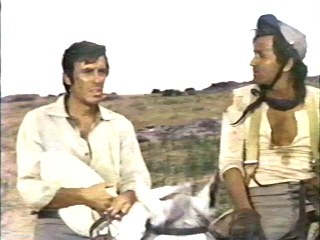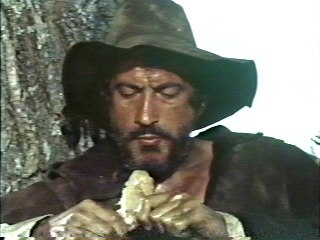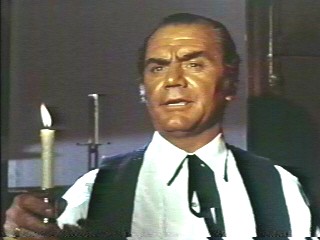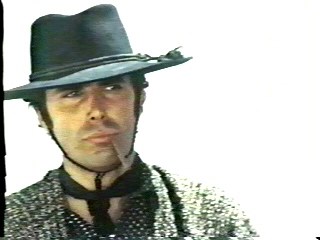
|
|
|
|
|
|
|
|
|
|
|
|
|
(1969) Director: Julio Buchs
It's pretty likely that if you are a fan of cult and kitsch movies, that sometime you have sat down to watch the goofy all-star The Oscar, and that you also plan to shout out the title the next time you are at a fantasy convention and renowned author Harlan Ellison (who wrote the movie) gets into one of his tiresome bitch-rants about the supposed bad quality of writing nowadays. Anyway, if you are able to recall the movie, you will remember that at the end, Frankie Fane (played by Stephen Boyd) had been knocked off his "glass mountain called success". Not only by failing to win the Oscar he so desperately craved, but by permanently alienating everyone around him due to his unbelievably selfish behavior. The last shot in the movie shows him slumped in his seat, wildly clapping while a big and crazy-looking grin forms on his face. Popular opinion of this last scene is that Fane has hit the ultimate bottom and he is going insane. But I actually disagree with this theory; it's too pat, too obvious. To fully understand this particular scene, you have to have a good knowledge of the film business at the time, not just in Hollywood but around the world. What many people don't know is that in the '60s, quite a
number of famous Hollywood actors suddenly found their movie careers
drying up. One other Hollywood actor who went to Europe was Ernest Borgnine; in fact, he was one of the first major American stars to go overseas to act in European movies. Though when you look at his resume, you'll see that his foreign acting credits aren't as extensive as his domestic ones. No doubt this is for several reasons; one is that Borgnine has a likeability that has endeared him to American audiences for decades, another being that his resume also shows he has had a willingness to accept roles in movies that don't measure up to his talents, and that Borgnine was never exactly the type you think of when you think of the macho heroes or romantic leads of European cinema. So understandably he was not cast as the lead in A Bullet For Sandoval. Instead, the role went to the European (Uruguayan, if you're nitpicky) George Hilton, who had already made a name for himself in many other spaghetti westerns. When the movie starts, his Confederate soldier character John Warner gets word on the eve of battle that his girlfriend Rosa is with child. He deserts and travels to his hometown not far from the Mexican border, but upon getting there finds she died from childbirth. Rosa's father Don Pedro Sandoval (Borgnine) - whom we learn has always despised John - is filled with absolute hatred, and immediately sends John and his newborn son out and away forever. This and outside circumstances make John unable to give the care needed while stuck in the wilderness, and the baby soon dies. John, now as cold and unforgiving as Sandoval, swears revenge. Though a revenged-themed spaghetti western is nothing
new, A Bullet For Sandoval still manages to be
remarkably different from others of its theme - and for On a similar note, the movie illustrates the futility of revenge; Sandoval's "revenge" by stranding John alone with his child just lead to John eventually swearing revenge on him. This disapproving look at revenge is evident even in the final showdown. It is hard to describe exactly how this is shown without spoiling things, except maybe by mentioning that neither man gets to do anything directly by himself; the audience therefore cannot vicariously live out any of its secret animalistic desires, and we instead are made to ingest the (unsensationalized) consequences that end the movie. Another way that A Bullet For Sandoval makes us see the utter wrongs of the entire situation is that it refuses to take sides. The typical take on this kind of formula would firmly make Sandoval the villain, and John a perfect hero of sorts. But as it turns out, neither of these men is portrayed in a particularly good or bad light. A less ambitious movie would probably have made Sandoval a total lout. But here he's seen showing love and warmth to his sons, and in one scene when nobody is watching him, he cannot hold his feeling back any longer and cries uncontrollably over the loss of his daughter. For that matter, John actions don't always make him a figure of sympathy. When he strikes back at a man that earlier denied him milk for his baby, his act of revenge is so vicious and cruel that even John's companions visibly show unease at what they are seeing. Up to this point, about a third of the way through the
movie, I was really enjoying A Bullet For Sandoval.
Everything about the movie was not only top-notch by itself, but was
working extremely well with Unfortunately, not long after John swore revenge, the movie more or less fell apart for me. It wasn't that the movie around this point stopped being so mysterious about the plot, and switched gears to become a fairly familiar western revenge type of drama. The fault instead came from it being badly handled, becoming alternately incoherent and taking detours along the way that end up doing little more than delay the inevitable showdown we know is coming. One example of the detours I'm talking about come from when Sandoval decides to take things directly into his hands, plastering posters all over the area that challenge John to a one-on-one fight. John gets word of this, travels to the plain where Sandoval has camped out, and both men engage in the two-man slow-shuffle forward. Before any man can go for his gun, they are surprised by one of Sandoval's sons riding in with guns blazing. John turns tail, leaving behind a doubly-pissed Sandoval. What was the point of all that? Sure, the scene had some suspense, and we get to see another of the quite eye-catching locations director Buchs found for the movie. But the scene is never referred to at any time again, and what happened in the scene doesn't seem to have affected the characters a bit. At least this part of the movie is handled marginally better than the subplot concerning the Confederate commander who is determined to bring John in because of his desertion from the army - the movie simply forgets about him before the end. Or maybe not. According to my sources, the movie is
listed with a running time significantly longer than the print I
watched on video, which was derived from the version
Check for availability on Amazon (VHS) See also: Bury Me An Angel, French Connection II, Valdez Is Coming |
 For a lot of these
stranded actors, the reason was age; heartthrobs like Rock Hudson and
Tony Curtis were getting too mature to make women young and old swoon.
The studios were also in turmoil, seemingly having to have lost much of
their ability to make box office hits; the credibility of the actors
attached to these flops therefore got hurt. Whatever the reason, all
these affected actors soon find themselves having to make some severe
changes to their career plans. Some of them, like Hudson, turned to
television. This obviously wasn't an option for Fane, because earlier
we saw how he more or less put himself on a television blacklist. Fane
was instead smiling because he knew of another option still available
for him, an option many real Hollywood actors took when they could no
longer find work in Hollywood - accept film role offers coming from
Europe. This option could be quite lucrative, something that Peter
Lawford former-actor-now-waiter character in the movie was apparently
too stupid to realize; Lee Van Cleef, for one, made enough money from
his work in Italian movies to not only buy a villa, but some sport
cars. And while Cleef didn't get too much Hollywood work after deciding
to make movies in Europe (a consequence some other Hollywood actors
found), he was at least considered a superstar in Europe, and the
showing of his movies in America did at least prevent him from being
forgotten on his home turf.
For a lot of these
stranded actors, the reason was age; heartthrobs like Rock Hudson and
Tony Curtis were getting too mature to make women young and old swoon.
The studios were also in turmoil, seemingly having to have lost much of
their ability to make box office hits; the credibility of the actors
attached to these flops therefore got hurt. Whatever the reason, all
these affected actors soon find themselves having to make some severe
changes to their career plans. Some of them, like Hudson, turned to
television. This obviously wasn't an option for Fane, because earlier
we saw how he more or less put himself on a television blacklist. Fane
was instead smiling because he knew of another option still available
for him, an option many real Hollywood actors took when they could no
longer find work in Hollywood - accept film role offers coming from
Europe. This option could be quite lucrative, something that Peter
Lawford former-actor-now-waiter character in the movie was apparently
too stupid to realize; Lee Van Cleef, for one, made enough money from
his work in Italian movies to not only buy a villa, but some sport
cars. And while Cleef didn't get too much Hollywood work after deciding
to make movies in Europe (a consequence some other Hollywood actors
found), he was at least considered a superstar in Europe, and the
showing of his movies in America did at least prevent him from being
forgotten on his home turf. that matter, most other spaghetti westerns.
It is a remarkably harsh movie, not that it contains any more violent
acts than usual, or that the individual violent acts shed more blood
and/or damage than what you typically find in the genre. The movie's
harshness instead comes from its tone. This tone is evident right in
the very first shot of the movie, a close-up shot of a scavenger on a
death-strewn battlefield using a knife to cut off a gold ring off a
corpse's finger. In a way, this opening shot kind of symbolizes both
John and Sandoval; both men are so determined and stubborn in their way
of thinking, that they don't seem to mind all that much what they have
to do in order to get what they want. As the movie continues on, both
men lose so much - John finds himself a wanted outlaw on both sides of
the border, Sandoval loses both a son and his standing in the eyes of
all those around him - yet each man remain steadfast. Both men remain
deaf to the pleas of those closest to them that concern the possibility
of thinking things over, or even getting out of the area. Needless to
say, each man won't even think about the fact that the other has a
legitimate beef with him. You sense that things will ultimately end
unhappily, or at the very least not as cut and dried as in other
westerns. The message that the movie seems to be trying to deliver is
that heartache will be the inevitable result with any conflict where
both sides are completely unwilling to bend.
that matter, most other spaghetti westerns.
It is a remarkably harsh movie, not that it contains any more violent
acts than usual, or that the individual violent acts shed more blood
and/or damage than what you typically find in the genre. The movie's
harshness instead comes from its tone. This tone is evident right in
the very first shot of the movie, a close-up shot of a scavenger on a
death-strewn battlefield using a knife to cut off a gold ring off a
corpse's finger. In a way, this opening shot kind of symbolizes both
John and Sandoval; both men are so determined and stubborn in their way
of thinking, that they don't seem to mind all that much what they have
to do in order to get what they want. As the movie continues on, both
men lose so much - John finds himself a wanted outlaw on both sides of
the border, Sandoval loses both a son and his standing in the eyes of
all those around him - yet each man remain steadfast. Both men remain
deaf to the pleas of those closest to them that concern the possibility
of thinking things over, or even getting out of the area. Needless to
say, each man won't even think about the fact that the other has a
legitimate beef with him. You sense that things will ultimately end
unhappily, or at the very least not as cut and dried as in other
westerns. The message that the movie seems to be trying to deliver is
that heartache will be the inevitable result with any conflict where
both sides are completely unwilling to bend.  everything else to
make an excellent whole. Among the most notable things to mention was
the acting. Borgnine is put through a tough workout, with Sandoval
being a character who is extreme in his emotions in almost every scene.
Borgnine doesn't just act well whatever particular emotion Sandoval
expresses, but acts it in a way that makes it consistent for the
character; you can believe the same man who acts as an ice-cold bastard
can later break down and weep. Hilton's dubbing makes it impossible to
critique his vocal acting, but he still manages to impress with very
convincing facial expressions, from grief to rage. The relatively
unknown (at least on these shores) music composer Gianni Ferrio
contributes a score not as "poingy" as those for typical spaghetti
westerns - which is appropriate in this case. His Tema Per Una
Vendetta suite is haunting and anguished, and snatches of his Oltre
Il Confine suite make excellent punctuation in that opening
sequence. What I enjoyed most about this entire section was that it
didn't let on early what the movie was going to be about. There is a
regular change of events, but whatever happened always left some
question of just what would happen next. Until John swore revenge, just
about anything could have happened, and I sat interested to see just
what would happen.
everything else to
make an excellent whole. Among the most notable things to mention was
the acting. Borgnine is put through a tough workout, with Sandoval
being a character who is extreme in his emotions in almost every scene.
Borgnine doesn't just act well whatever particular emotion Sandoval
expresses, but acts it in a way that makes it consistent for the
character; you can believe the same man who acts as an ice-cold bastard
can later break down and weep. Hilton's dubbing makes it impossible to
critique his vocal acting, but he still manages to impress with very
convincing facial expressions, from grief to rage. The relatively
unknown (at least on these shores) music composer Gianni Ferrio
contributes a score not as "poingy" as those for typical spaghetti
westerns - which is appropriate in this case. His Tema Per Una
Vendetta suite is haunting and anguished, and snatches of his Oltre
Il Confine suite make excellent punctuation in that opening
sequence. What I enjoyed most about this entire section was that it
didn't let on early what the movie was going to be about. There is a
regular change of events, but whatever happened always left some
question of just what would happen next. Until John swore revenge, just
about anything could have happened, and I sat interested to see just
what would happen. that played in
American theaters. This could possibly explain the reason for the
Confederate commander's disappearance; it certainly seems to explain
why the IMDb lists an acting credit for the part of John's girlfriend
Rosa, when this character never actually appeared at any time in the
print I watched. Unless I can find an uncut version in the picture, I
don't know whether to assume the remaining head-scratching moments come
from the cuts or were a case of incompetence by the screenwriter and/or
director. All I can do is mention them, like how the fallen monk
character that joins up with John is a really promising character (and
well played by Leo
Anchóriz), but is given almost nothing to do or say afterwards. Or how
John's bandit party suddenly jumps from three to six members (with one
of them almost immediately killed off after he's introduced.) Or that
John has such little personal interaction with the members of his
bandit party, we not only don't know just what the gang is doing to
pass the time until reaching Sandoval, we don't know just why they are
willing to put their lives on the line so John can reach Sandoval. Such
questions might not stop die-hard spaghetti western fans from enjoying
A Bullet For Sandoval... though I realize
most people aren't die-hard spaghetti western fans. So it's pretty
clear what my advice must be for this movie. Which is: First watch all
those other spaghetti westerns that I've recommended, learn to love
them, then sit down and enjoy A Bullet For Sandoval
despite all its flaws.
that played in
American theaters. This could possibly explain the reason for the
Confederate commander's disappearance; it certainly seems to explain
why the IMDb lists an acting credit for the part of John's girlfriend
Rosa, when this character never actually appeared at any time in the
print I watched. Unless I can find an uncut version in the picture, I
don't know whether to assume the remaining head-scratching moments come
from the cuts or were a case of incompetence by the screenwriter and/or
director. All I can do is mention them, like how the fallen monk
character that joins up with John is a really promising character (and
well played by Leo
Anchóriz), but is given almost nothing to do or say afterwards. Or how
John's bandit party suddenly jumps from three to six members (with one
of them almost immediately killed off after he's introduced.) Or that
John has such little personal interaction with the members of his
bandit party, we not only don't know just what the gang is doing to
pass the time until reaching Sandoval, we don't know just why they are
willing to put their lives on the line so John can reach Sandoval. Such
questions might not stop die-hard spaghetti western fans from enjoying
A Bullet For Sandoval... though I realize
most people aren't die-hard spaghetti western fans. So it's pretty
clear what my advice must be for this movie. Which is: First watch all
those other spaghetti westerns that I've recommended, learn to love
them, then sit down and enjoy A Bullet For Sandoval
despite all its flaws.